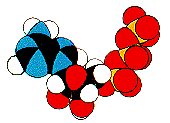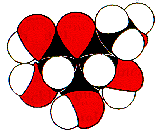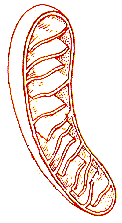
The Energy Systems

In order to perform the muscle responses necessary for us to perform the act of running, we must produce energy from the food that we consume. Energy must be converted from chemicals, by the muscle cells, into work. All of the work done by our running muscles is supplied from the chemical breakdown of ATP (adenosine triphosphate).
One of my favorite books is Covert Bailey's "Fit or Fat". He does a very good job of providing non-chemists like myself with a clear understanding of how food is broken down and converted into ATP. Tracing the food from the saliva breakdown to the point of its metabolic journey where the body is presented with a fork in the road, we are able to understand clearly the production of ATP. At this juncture, we see two choices: aerobic or anaerobic production of ATP. The first choice produces much more ATP per unit of glucose than does the other. The anearobic system, although adequate, has the disadvantage of producing the by-product lactic acid. That's why you want to use the aerobic system as much as possible for the source of your ATP. I'll cover all of this in greater detail in a moment.
I believe it is through a clear understanding of these metabolic pathways that we can better understand the reasons behind the types of training that are necessary to become good at the sport of running. When you read the "Basic Training" chapter in this mini-book, you will be given information that will show you the type of training that can help you to produce as much of the ATP as possible using the aerobic pathway. Yet it is inevitable that when we push ourselves to the limits of our physical boundaries, we will be using both the aerobic and anaerobic pathways to produce the ATP. The objective of our training, consequently, should include the types of training that will postpone the the inevitable anaerobic process, and to physically and mentally prepare us to handle the lactic acid when the system finally begins to anaerobicly produce the ATP.
One of the things I like most about the 10km distance is the fact that it takes you through three stages of ATP production throughout the race. You start out aerobic; then you go through a threshold period where you are both aerobic and anaerbic, and finally toward the later stages of the race, you are predominantly anaerobic. By training to handle each of these stages in an optimal fashion, you can really trim down your 10km times. It's a great racing distance to really see the fruits of your training.

If we could see an ATP molecule, it would look something like the molecular model shown above. Of course, it would not have the color code you see here. The white atoms are hydrogen; the black ones carbon; the blue ones nitrogen; the red ones are oxygen, and the yellow ones are phosphorus. The actual size of an ATP molecule is about 1 1/2 nanometers. If your screen is like mine, you're looking here at a picture of an ATP molecule that is about 5 1/2 centimeters from end to end. That's almost 16 million times larger than it actually is.
It takes thousands of these ATP molecules to bring about the muscle contractions necessary for running. Leg muscle contractions are the result of a sliding action between two interleafed filaments called actin and myosin. The myosin has heads extending from hinged arms that will attach themselves to the underside of the actin filaments and then do what is called a "power stroke" everytime an ATP molecule loses a high energy phosphate bond (i.e. the red and yellow-coded atoms break away from the white, black and blue ones). After each power stroke, the myosin must be detached and reattached in order for the cycle to be repeated. More high energy phosphate bonds have to be broken to repeat the action. Each ATP molecule is good for a few strokes. It takes millions of strokes for you to run; and many muscle fibers must be recruited.
If a muscle fiber is recruited by you and it does not have the ATP it needs to detach the myosin head, the fiber becomes locked up. If enough of these are locked up, you can't run! And if a lot of them are locked up, running becomes tough.

I call it the "motherload", because most of the ATP we use for running comes from glucose. The molecular model shown above depicts glucose as a sugar consisting of 6 carbon atoms, 12 hydrogen atoms, and 6 oxygen atoms. Glucose is derived primarily from the carbohydrates and fats that we eat. Glucose carried in the blood is often referred to as "blood sugar".
Glucose, when stored in the muscles and liver, has the same atomic ingredients but slightly different molecular structure. This is just another way of saying that the atoms in stored glucose are hooked together a little differently than they are in the mobile form of glucose. In the stored form, it is called "glycogen". Once glucose is formed in the body, it must either be consumed by forming ATP (or any of its chemical derivatives), or stored as glycogen, or it will be converted into fat.
Under extreme conditions, where there is not an adequate amount of glucose circulating in the blood or there is not enough stored fat, the body will chemically convert protein to glucose. This can be a dangerous situation if done on a continued basis, and literally begins to "eat" muscle tissue. Therefore, one should always make sure they at least consume the minimum levels of carbohydrates and fats to avoid protein being converted to glucose. For most of us, this is never a problem. You would have to be starving the body, or putting in a ridiculous level of running mileage.
Some low levels of protein to glucose conversion may occur during marathon and ultra-distance training. Aside from the fact, that you begin to look like you are a member of a prison camp, you may also begin to smell a slight ammonia aroma in your perspiration. Ammonia is a by-product of the protein-to-glucose conversion process.
As mentioned earlier in this chapter, glucose or glycogen can be converted to ATP with or without oxygen, but the preferred method is to do so with oxygen. This is no easy task when you are training hard or running a race. So the trick is to keep the process as aerobic as possible; and your ability to do so, is your measure of oxygen power. Incidentally, I did not invent the label "oxygen power". For a more complete explanation of oxygen power, you may want to refer to the publication "Oxygen Power. Performance Tables for Distance Runners" by Jack Daniels and Jimmy Gilbert."
The chief reasons for wanting to produce the ATP aerobically are: (1) you do not want to pool lactic acid, the by-product of anaerobic ATP production, and (2) anaerobic production of ATP is very inefficient when compared to the aerobic production. Actually, pooled lactic acid is merely proof of lots of inefficient production of ATP, and a resulting shortage of available ATP for the muscle activity.
Trying to continue muscle activity without the needed ATP is not really possible, but because the muscle fibers are connected to each other, a form of inertia forces these muscles to try and respond. Some neighboring fibers may have the needed ATP for the myosin and actin power stroke interaction, continue firing, and moving the body forward, but with noticeable pain. Scientists also believe the acid itself contributes to the pain, as a means of "mother nature" telling us to ease off a bit. This is why, it is important to include workouts that will increase the body's ability to buffer the acid, as well as teach it to convert lactic acid back into glucose. Actually, lactic acid is glucose cut in half. There are half as many carbon atoms, half as many hydrogen atoms, and half as many oxygen atoms. So chemically it is easy to see how lactic acid can be converted back to glucose.
That's right--certain types of training teach the body to efficiently oxidize some of the lactic acid into carbon dioxide and water. The energy produced from that conversion can then be used to turn other molecules of lactic acid back into glycogen.
I mentioned the inefficiencies of anaerobic ATP production. Let's talk numbers. If you are able to convert the glucose to ATP using an adequate supply of oxygen, the net yield from just one molecule of glucose will be 36 molecules of ATP. If you do not have enough oxygen, the net yield is only 2 molecules of ATP. Consequently, you can see that the aerobic process is 18 times more efficient.
Most of the conversion of glucose to ATP happens inside tiny little organelles that are found in the muscle tissue. They are called "mitochondria". The picture shown above depicts a mitochondria that has been greatly magnified. The type and amount of training you do determines the quantity of mitochondria within the muscle tissue. It is part of the body's adaptation process. After a certain period of training requiring high levels of ATP, the body begins to say, "Hey, I need to build more factories to process ATP--there aren't enough!" So, the body builds more factories.
If you would like to see what a mitochondria looks like through the eye of an electron microscope, then click here.
(Under construction. This section will be finished as I find more time to write.